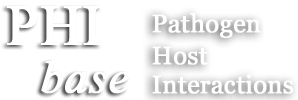Example search terms: loss of pathogenicity, Candida, Enterococcus, Magnaporthe oryzae, wheat, azole, spot blotch disease, PHI:1020, ABC1, anti-infective. Type * to browse database.
From mutant genes to phenotypes! The mission of PHI-base is to provide expertly curated molecular and biological information on genes proven to affect the outcome of pathogen-host interactions. Information is also given on the target sites of some anti-infective chemistries.
PHI-base data
 Submit your published phenotype data
Submit your published phenotype data
![]() Text search
Text search
Search terms are auto completed when entries are found.
 PHIB-BLAST
PHIB-BLAST
Find homologs and their phenotypes
 Submit data
Submit data
Manual curation of the pathogen interaction literature
 How to cite us:
How to cite us:
Urban, M. et al (2025). NAR. doi: 10.1093/nar/gkae1084
Tweets by @PHI_base
PHI spotlight
PHI-base 4 will remain online until end of 2025. Please use this version to download complete datasets. The PHI-Canto community interspecies curation tool and framework description is available here: Cuzick et al, 2023, doi 10.7554/ eLife.84658.
A short overview is provided in an associated eLife digest.



PHI-base is funded by the Biotechnology and Biological Sciences Research Council (BBSRC, UK) and is being developed and maintained by scientists at Rothamsted Research.
Home | About Us | Disclaimer & Privacy Policy | Contact Us

